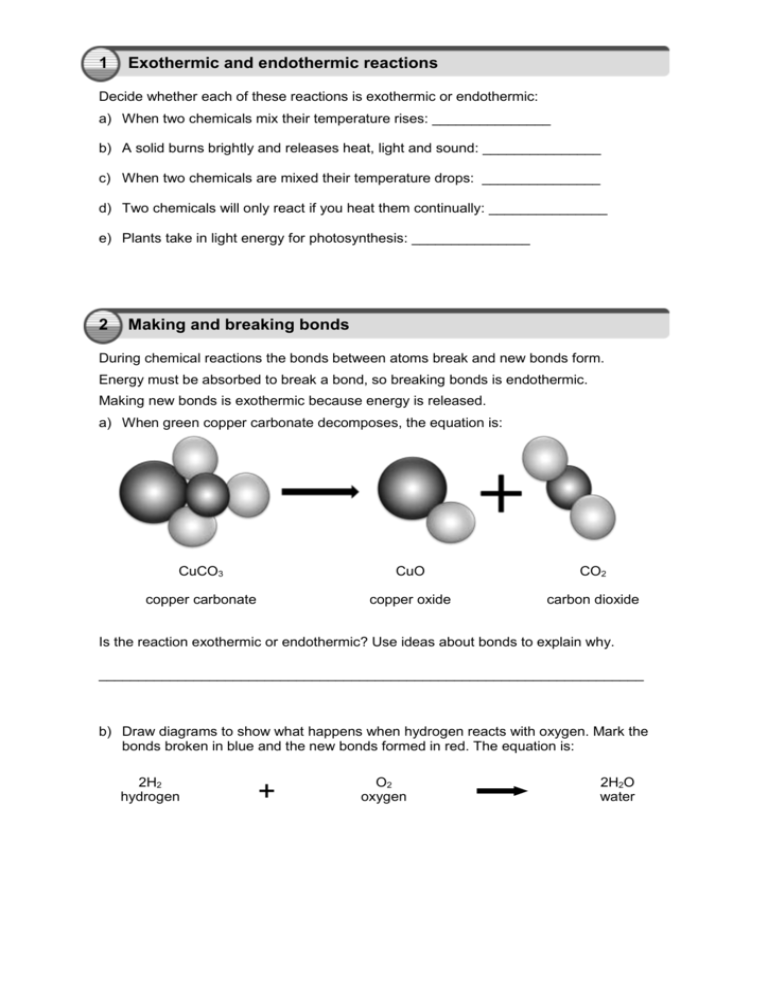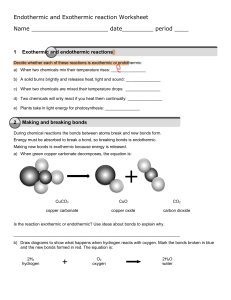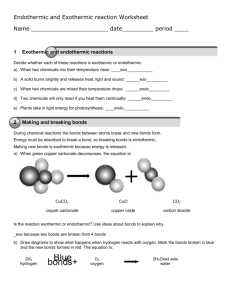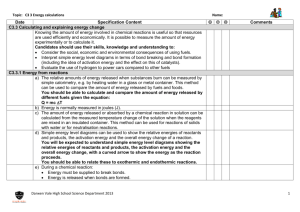File - Ms. McRae`s Science
advertisement

1 Exothermic and endothermic reactions Decide whether each of these reactions is exothermic or endothermic: a) When two chemicals mix their temperature rises: _______________ b) A solid burns brightly and releases heat, light and sound: _______________ c) When two chemicals are mixed their temperature drops: _______________ d) Two chemicals will only react if you heat them continually: _______________ e) Plants take in light energy for photosynthesis: _______________ 2 Making and breaking bonds During chemical reactions the bonds between atoms break and new bonds form. Energy must be absorbed to break a bond, so breaking bonds is endothermic. Making new bonds is exothermic because energy is released. a) When green copper carbonate decomposes, the equation is: CuCO3 CuO CO2 copper carbonate copper oxide carbon dioxide Is the reaction exothermic or endothermic? Use ideas about bonds to explain why. _____________________________________________________________________ b) Draw diagrams to show what happens when hydrogen reacts with oxygen. Mark the bonds broken in blue and the new bonds formed in red. The equation is: 2H2 hydrogen + O2 oxygen 2H2O water 3 ‘Make or break’ a) Most reactions involve bond breaking and bond making. This equation shows what happens when methane (CH4) burns in oxygen (O2). Mark the bonds broken in blue and the bonds formed in red. b) Complete the table to show the number of bonds broken and formed: Bonds broken Number Bonds formed between carbon and hydrogen between carbon and oxygen between oxygen atoms between hydrogen and oxygen Number c) Is the reaction exothermic or endothermic overall? ________________________________________________________________________ d) The overall energy change is decided by the strength of the bonds that are broken or formed during the reaction. The stronger the bond the larger the energy change. Which bonds must be stronger in this reaction – the bonds broken or the new bonds formed? ________________________________________________________________________ energy e) An energy level diagram shows the energy taken in and released during the reaction. Add the reactants, products and their separated atoms to the correct places on the diagram. reactants products course of the reaction 1 Comparing fuels A student wanted to compare the energy released when 4 different fuels burned. To make it a fair test she put 1 g of each fuel in a little dish. Then she burned each fuel under a calorimeter containing 200 cm³ of water. These are her results: Fuel methanol Temperature at the start in °C 25 Temperature at the end in °C 56 ethanol 18 53 propanol 17 54 butanol 23 63 Temperature rise in °C a) Calculate each temperature rise and state which fuel releases most energy per gram. ________________________________________________________________________ Another student used spirit burners for the experiment. She had to weigh them before and after each test to find out how much fuel she had used. To make it a fair test she used each fuel to make the same amount of water 10°C hotter. These are her results: Fuel methanol ethanol propanol butanol Mass of burner at the start in g 154.3 213.4 185.8 198.5 Mass of burner at the end in g 150.7 210.6 183.4 196.3 Mass of fuel used in g b) Calculate the mass of each fuel she had to use to release the same amount of energy, and state which fuel must release more energy per gram. ________________________________________________________________________ c) What could these students do to prove their results were repeatable? ________________________________________________________________________ d) Results are reproducible if they lead to the same conclusions when different people do the experiments or when different methods are used. Are the results reported on this page reproducible? ________________________________________________________________________ 2 Energy transfer The energy a fuel releases is measured in joules (J) or kilojoules (kJ). To find this value we need to know how much energy was transferred to the water. This depends on two things: the mass of water heated and its temperature rise. Each cm3 of water has a mass of 1 g, and each gram of water takes 4.2 J to make it 1°C hotter. So the energy transferred to the water can be calculated using this equation: temperature energy mass of water × 4.2 × = change (°C) transferred (J) heated (g) The results in the table below were obtained when four different fuels were used to heat 100 cm3 of water. Calculate the amount of energy each fuel transferred. To compare fuels fairly we need to know how much energy they release per gram. This can be found by dividing the total energy transferred by the grams of fuel used. energy per gram = energy supplied (J) mass of fuel burnt (g) a) Calculate the energy each fuel transferred per gram. Fuel Temperature before in C Temperature before in C A B C D 20 21 19 20 56 64 52 61 3 Temperature difference in C Energy transferred in J Mass of fuel used in g 3.2 4.3 3.6 3.9 Energy per gram in J/g Rearranging equations If you want to calculate the amount of energy transferred the equation below is ideal, but suppose you wanted to know the mass of water heated or the temperature change. temperature energy mass of water × 4.2 × = change (°C) transferred (J) heated (g) To make the equation more useful it can be rearranged. a) To find the temperature change, divide both sides of the equation by the ‘mass of water heated × 4.2’. Write out the new equation. ________________________________________________________________________ b) To find the mass of water heated, divide both sides of the equation by ‘4.2 × the temperature change’. Write out the new equation. ________________________________________________________________________









